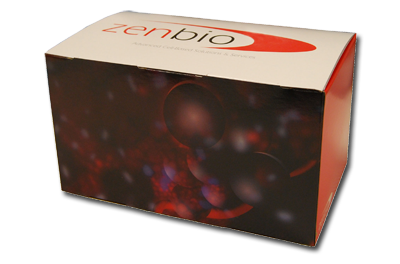Serum / Plasma Fatty Acid and Glycerol Detection Kits 血清/血漿脂肪酸和甘油檢測試劑盒
產品型號: SFA
The level of non-esterified fatty acids (NEFA) and glycerol in serum or plasma is indicative of endogenous or induced adipocyte lipolysis. Fatty acids and glycerol are released by adipocytes in response to lipolytic hormones and enter the bloodstream for utilization by other tissues. However, an excess of circulating fatty acid over energy needs may contribute to hyperlipidemia, which is a risk factor for cardiovascular disease.
ZenBio offers kits to analyze the levels of NEFA, glycerol, or both in human and animal serum or plasma. The kits are designed for use in a 96-well format. Through a two-step addition process, the level of NEFA can be quantified relative to a standard curve. Glycerol detection is monitored through a one-step addition and colorimetric assessment.
| Item# | Item Desc | U/M |
| SFA-1 | Serum/Plasma Fatty Acid Detection Kit - 1 plate | KIT |
| SFA-5 | Serum/ Plasma Fatty Acid Detection Kit - 5 plate | KIT |
| SFA-10 | Serum/ Plasma Fatty Acid Detection Kit - 10 plate | KIT |
| GFA-1 | Serum/ Plasma Glycerol and Fatty Acid Detection Kit | KIT |
| SGA-1 | Serum/ Plasma Glycerol Detection Kit | KIT |
| FFA-STAN | Free Fatty Acid Standard,100ul | EA |
- 96-well Serum/Plasma Fatty Acid Kit - 100 Point Kit (SFA-1) (pdf)
This kit is designed to accurately determine the amount of free fatty acid present in blood, serum or plasma of humans, mice, rats, and other animals in a 96-well format for increased throughput analysis. Blood can be collected in plain evacuated tubes or in the presence of common anti-coagulants: sodium citrate, ammonium oxalate and EDTA. NOTE: Heparin or Heparinized tubes should not be used because this will generate inaccurate readings. Serum should be separated from clotted blood by centrifugation as soon as possible and may be stored frozen (-20°C) prior to analysis. - 96-well Serum/Plasma Fatty Acid Kit - 500 Point Kit (SFA-5) (pdf)
This kit is designed to accurately determine the amount of free fatty acid present in blood serum or plasma of humans, mice, rats, and other animals in a 96-well format for increased throughput analysis. Blood can be collected in plain evacuated tubes or in the presence of common anti-coagulants: sodium citrate, ammonium oxalate and EDTA. NOTE: Heparin or Heparinized tubes should not be used because this will generate inaccurate readings. Serum should be separated from clotted blood by centrifugation as soon as possible and may be stored frozen (-20°C) prior to analysis. - 96-well Serum/Plasma Fatty Acid Kit - 1000 Point Kit (SFA-10) (pdf)
This kit is designed to accurately determine the amount of free fatty acid present in blood serum or plasma of humans, mice, rats, and other animals in a 96-well format for increased throughput analysis. Blood can be collected in plain evacuated tubes or in the presence of common anti-coagulants: sodium citrate, ammonium oxalate and EDTA. NOTE: Heparin or Heparinized tubes should not be used because this will generate inaccurate readings. Serum should be separated from clotted blood by centrifugation as soon as possible and may be stored frozen (-20°C) prior to analysis. - Serum/Plasma Glycerol and Fatty Acid Detection Kit (GFA-1) (pdf)
This kit is designed to accurately determine the amount of free fatty acid and glycerol present in blood serum or plasma of humans, mice, rats, and other animals in a 96-well format for increased throughput analysis. Blood can be collected in plain evacuated tubes or in the presence of common anti-coagulants: sodium citrate, ammonium oxalate and EDTA. NOTE: Heparin or Heparinized tubes should not be used because this will generate inaccurate readings. Serum should be separated from clotted blood by centrifugation as soon as possible and may be stored frozen (-20°C) prior to analysis. - 96-well Serum/Plasma Glycerol Detection Kit (SGA-1) (pdf)
This kit is designed to accurately determine the amount of glycerol present in blood serum or plasma of humans, mice, rats, and other animals in a 96-well format for increased throughput analysis. Blood can be collected in plain evacuated tubes or in the presence of common anti-coagulants: sodium citrate, ammonium oxalate and EDTA. NOTE: Heparin or Heparinized tubes should not be used because this will generate inaccurate readings. Serum should be separated from clotted blood by centrifugation as soon as possible and may be stored frozen (-20°C) prior to analysis.



